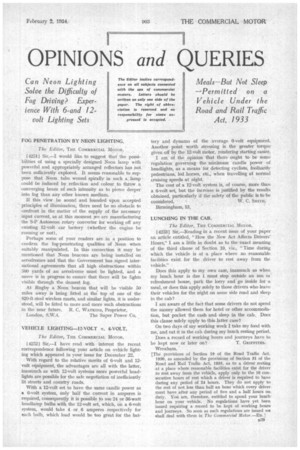OPINIONS and QUERIES FOG PENETRATION BY NEON LIGHTING.
Page 53

If you've noticed an error in this article please click here to report it so we can fix it.
The Edilor, THE COMMERCIAL MOTOR.
[4251] would like to suggest that the possi bilities of using a specially designed Neon lamp with powerful and appropriately arranged reflectors has not been sufficiently explored. It seems reasonable to suppose that Neon tube wound spirally in such a. lamp could be induced by reflection and colour to throw a converging beam of such intensity as to pierce deeper into fog than any other known medium.
If this view be sound and founded upon accepted principles of illumination, there need be no obstacle to confront in the matter of the supply of the necessary input current, as at this moment ;Aro are manufacturing the S-P Autoneon rotary converter for working off any existing 12-volt car battery (whether the engine be running or not).
Perhaps some of your readers are in a position to confirm the fog-penetrating qualities of Neon when suitably manipulated. In this connection it may be mentioned that Neon beacons are being installed on aerodromes and that the Government has signed international agreements that all high obstructions within 500 yards of an aerodrome must be lighted, and a move is in progress to ensure that there will be lights visible through the densest fog.
At Rugby a Neon beacon that will be visible 50 miles away is being fitted at the top of one of the 820-ft steel wireless masts, and similar lights, it is understood, will be fitted to more and more such obstructions in the near future. R. C. WATKINS, Proprietor,
London, S.WA. The Super Power Co.
VEHICLE LIGHTING—I2-VOLT v. 6-VOLT.
The Editor, THE COMMERCIAL MOTOR.
142521 Sir, —I have read with interest the recent correspondence following your article on vehicle lighting which appeared in your issue for December 22.
With regard to the relative merits of 6-volt and 12volt equipment, the advantages are all with the latter, inasmuch as with 12-volt systems more povirerful headlights are possible for the safe negotiation of inefficiently lit streets and country roads.
With a 12-volt set to have the same candle power as a 6-volt system, only half the current in amperes is required, consequently it is possible to use 24 or 36-watt headlamp bulbs with the 12-volt set, which, on a 6-volt system, would take 4 or 6 amperes . respectively for each bulb, which load would be too great for the bat
tery and dynamo of the average 6-volt equipment. Another point worth stressing is the greater torque given off by the 12-volt motor, rendering starting easier.
Iam of -the opinion that there ought to be some regulation governing the minimum candle power of headlights, as a means for detecting cyclists, foolhardy pedestrians, led horses, etc., when travelling at normal cruising speeds at night.
The cost of a 12-volt system is, of course, more than a 6-volt set but the increase is justified by the results obtained, particularly if the safety of the public is tb be considered. W. C. SMITH. Birmingham, 13.
LUNCHING IN THE CAB.
The Editor, THE COMMERCIAL MOTOR. , [4253] Sir,—Reading in a recent issue of your paper an article entitled, "I-low the New Act Affects Drivers Hours," I am a little in doubt as to the exact meaning of the third clause of Section 19, viz., "Time during which the vehicle is at -a place where no reasonable facilities exist for the driver to rest away from the vehicle."
Does this apply to my own case, inasmuch as when my lunch hour is due I must stop outside an inn oi refreshment house, park the lorry and go inside for a meal, or does this apply solely to those drivers who leave their vehicles for the night on some side road and sleep in the cab?
I am aware of the fact that some drivers do not spend the money allowed them for hotel or other accommodation, but pocket the cash and sleep in the cab. Does this clause solely apply to this latter case?
On two days Of my working week I take my food with me, and eat it in the cab during my lunch resting period. Does a record of working hours and journeys have to be kept now or later on? T. GkreFrrus. Wrexham.
[The provisions of Section 19 of the Road Traffic Act, 1930, as amended by the provisions of Section 91 of the Road and Rail Traffic Act, 1993, as to a driver resting at a place where reasonable facilities exist for the driver to rest away from the vehicle, apply only to the 10 consecutive hours of rest which a driver is requited to have during any period of 24 hours. They do not apply to the rest of not less than half an hour which every drivermust have after any period of five and a half hours on duty. You are, therefore, entitled to spend your lunch' hour on your vehicle. No regulations have yet been issued requiring a record to be kept of working hours and journeys. So soon as such regulations are issued we shall deal with them in The Commercial Motor.—ED.]




























































































